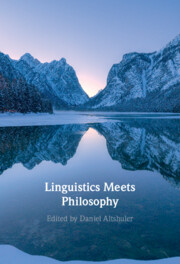Book contents
- Linguistics Meets Philosophy
- Linguistics Meets Philosophy
- Copyright page
- Contents
- Figures
- Tables
- Contributors
- Linguistics Meets Philosophy: A Historical Preface
- Introduction
- Part I Reporting and Ascribing
- 1 Attitude Ascriptions and Speech Reports
- 2 Acquaintance Relations
- Part II Describing and Referring
- Part III Narrating and Structuring
- Part IV Locating and Inferring
- Part V Typologizing and Ontologizing
- Part VI Determining and Questioning
- Part VII Arguing and Rejecting
- Part VIII Implying and (Pre)supposing
- Index
- References
1 - Attitude Ascriptions and Speech Reports
from Part I - Reporting and Ascribing
Published online by Cambridge University Press: 06 October 2022
- Linguistics Meets Philosophy
- Linguistics Meets Philosophy
- Copyright page
- Contents
- Figures
- Tables
- Contributors
- Linguistics Meets Philosophy: A Historical Preface
- Introduction
- Part I Reporting and Ascribing
- 1 Attitude Ascriptions and Speech Reports
- 2 Acquaintance Relations
- Part II Describing and Referring
- Part III Narrating and Structuring
- Part IV Locating and Inferring
- Part V Typologizing and Ontologizing
- Part VI Determining and Questioning
- Part VII Arguing and Rejecting
- Part VIII Implying and (Pre)supposing
- Index
- References
Summary
Attitude ascriptions and speech reports were at the center of attention when philosophers and logicians began to see natural languages as formal systems. My chapter looks at the history of formal semantics, not for its own sake, but for lessons about how to approach attitude ascriptions and speech reports today. I think we may have taken a few wrong forks in the road. To solve the problem of logical equivalents, we should have listened to Rudolf Carnap, who made it clear that the fact that the truth of an attitude ascription or speech report may depend on the intensional structure of the embedded clause in no way forces the conclusion that propositions can’t be mere intensions. For de re ascriptions, we should have listened to David Kaplan, who replaced names in the scope of attitude verbs with descriptions, rather than associating the individuals those names stand for with modes of presentation. What held us back in both cases was Fregean compositionality. Shedding that legacy, I present prototypes for analyses of attitude verbs and verbs of speech within an intensional semantics where propositions are mere sets of possible worlds and de re ascriptions require no special technologies created just for them.
Keywords
- Type
- Chapter
- Information
- Linguistics Meets Philosophy , pp. 17 - 50Publisher: Cambridge University PressPrint publication year: 2022



